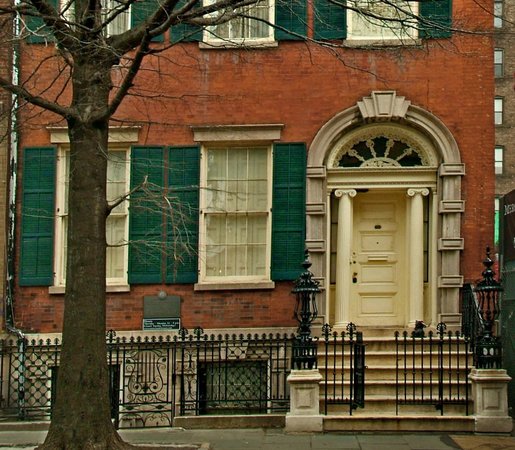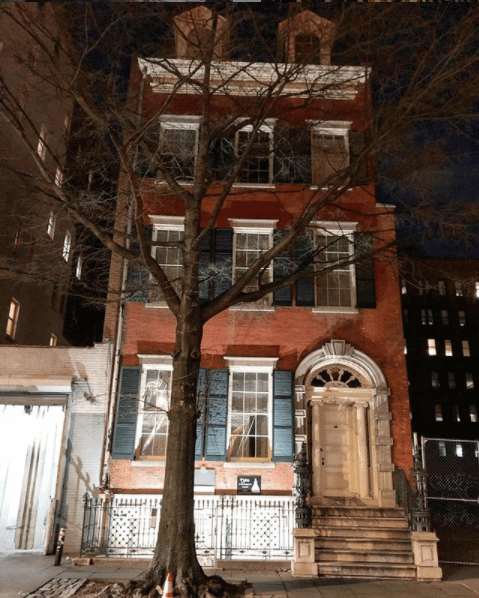Museum Visit: New Yorks Merchants House Museum
Sharon Twickler Magazine
All photographs are courtesy of the Merchants House Museum.
It was a dark and stormy afternoon when I toured the old Merchants House. Forgive my dramatic tone, reader, but for a house as storied as this one, its warranted. The museum, located in dowtown New York City on East Fourth Street, interprets nineteenth-century domestic life through the home and furnishings of a prosperous merchant family and their four Irish servants. Truly a portal to the past, the house is a Victorian time capsule, having been inhabited by the same family for nearly a hundred years. It retains all the original furnishings. Stunning inside and out, its red brick facade with Ionic columns and ornamental ironwork only hints at the jaw-dropping interiors that await.
As I began my tour I was handed a booklet and instructed to proceed to the garden behind the house. The sky was still clear as I stood in this sanctuary of stone and lush greenery, a far cry from the working yard of dirt and grass it had been in the nineteenth century. The museums gardener, John Rommel, has been a devoted volunteer since 1995 and continued to tend to the verdant space even when the museum was closed at the height of the pandemic. After admiring his handiwork, I open the guidebook and begin to get acquainted with the house and its residents.
Chandler photograph.Chandler photograph.Chandler photograph.
Recommended Attractions At Popular Destinations
What Other Similar Attractions Are Recommended In New York
Recommended Reading: Buy Metropolitan Museum Of Art Tickets Online
What Is The Merchants House Museum
Formerly known as the Seabury Tredwell House and the Old Merchants House, the Merchants House Museum is New York Citys only intact nineteenth-century family home, both inside and out. It was built in 1832 on speculation by a hatter by trade, Joseph Brewster, and is located at 29 East Fourth Street in Manhattan, between the Bowery and Lafayette Street. George Chapman, the familys cousin who once lived there, founded the museum in 1936.
The house was one of the first 20 buildings under the citys new landmarks law in 1965. Its the only historic house museum in Greenwich Village, Soho, and NoHo.
Popular Restaurants In New York

Club A SteakhouseThe River CaféB Side Pizza & Wine BarShake ShackDANIELBurger & LobsterLadureeEleven Madison ParkAi FioriLittle Sheep Mongolian Hot PotLuke’s Lobster Saigon ShackEN Japanese BrasserieChikaLicious Dessert BarGabriel KreutherDominique Ansel BakeryKeens SteakhouseChina BlueJack’s Wife FredaGallaghers SteakhouseThe Halal GuysAbsolute BagelsLe CoucouThai ViilaLady M Cake BoutiqueBenjamin SteakhouseAtera
You May Like: Chicago Museum Of Art Christmas Cards
Help Us Save The Merchants House Museum
As you may have heard by now if you follow us on social media, were gravely concerned about the fate of the historic and irreplaceable Merchants House Museum, which is currently threatened by the proposed construction of an 8-story hotel to be built directly next door.
In order to fight the developers, the MHM needs lots of community support, but it also needs a legal team. To assist the Museum with their legal fees, weve added an option to donate $5 to the Museum with every Ultimate Greenwich Village Ghost Tour ticket purchase. Simply click the box to donate $5 when you buy your tickets, and well give 100% of the net proceeds to the MHMs legal defense fund.
More about the proposed construction
In 2014, the Landmarks Preservation Commission approved a plan for construction of an eight-story hotel next door to the Merchants House Museum, at 27 East 4th Street. The 1832 Merchants House is a city, state, and federal landmark. In New York City, it is one of only 119 buildings that is both an exterior and an interior landmark. Remarkably, landmark status does not guarantee protection from adjacent construction.
Vicinity Of The Merchants House: The Bond Street Area
When the Seabury Treadwell family moved into their 29 East 4th Street row house in 1835, they were living in one of New York’s most fashionable and best-known residential neighborhoods: the Bond Street area, which consisted of the east-to-west streets north of Houston Street and adjacent to Broadway, specifically, Bleecker, Bond, Great Jones, and East 4th Streets. Highly desirable Lafayette Place, location of the famed Colonnade Row, ran north-to-south several blocks from Astor Place to Great Jones Street.
There, elegant brick and marble-front row houses and mansions, the homes of some of New York’s leading families, lined the serene tree-lined streets. “The elegance and beauty of this section cannot be surpassed in the country,” exclaimed one New York newspaper in 1835.
After the Civil War, the Bond Street area lost all semblance of its patrician past. The elegant dwellings became “restaurants of private boarding-houses, barroom or groceries, peculiar physicians’offices or midwives’ headquarters.” Other houses became sweatshops, lofts, or warehouses.
Only a bedraggled handful of row houses survive on Bleecker, Bond, Great Jones, and East 4th Streets. On Bond Street, for instance, only No. 26, with its elaborate fanlight doorway and dormer windows intact, recalls the street’s past dignity. A few pathetic houses still stand at the Broadway and Bowery ends of the block–the basement and first floors converted into a store front or truck-loading platform.
You May Like: Dream Space Museum Los Angeles
Miracle On Fourth Street
Joseph Brewster constructed a brick and marble row residence on Fourth Street in an exclusive, quiet suburb of New York City in 1832, 190 years ago. Three years later, in 1835, wealthy merchant Seabury Tredwell bought the house and moved in with his wife, Eliza, eight kids, and four Irish servants. They resided in the house for nearly a century.
Thankfully, that merchants house still exists today. Since 1936, it has been accessible to the general public as a museum.
Support The Museum By Buying A Book
Miracle on Fourth Street is the story of the preservation of a family home that belonged to one of the early merchants of New York City. Lived in by one family for almost 100 years, the house was preserved as a museum upon the death of the last family member.
The book recounts the struggle of the founder of the museum to realize his quixotic vision, the critical intervention of an architect who devoted his life to an authentic structural restoration, and the dedication of a group of professional women who would not give up their goal of reclaiming the beauty of the original furnishings.
It is a story of creative solutions to structural calamities, heartbreaking setbacks, disappointing personality conflicts, and the current stewards triumph over a final brutal assault on the building that quite literally could have brought the house down
Also Check: Museum Of Jewish Heritage Theater
Learn About The Merchants House Museum
The citys museums and galleries are among its most powerful draws. The American Museum of Natural History, the Metropolitan Museum of Art, and the Whitney Museum of American Art all house massive collections and host spectacular exhibitions. When you combine these with the numerous galleries throughout the city, visiting New York becomes a visually striking experience.
However, the museums listed above are not the only ones worth seeing in New York City. The Merchants House, complete with the familys household objects, original furnishings, personal possessions, and even their clothing, offers an intimate peek at domestic life during the era when New York changed from a mercantile seaport to the center of US commerce and a thriving metropolis.
This row house, built in 1832, was home to an affluent merchant-class family, the Tredwells, and their Irish servants for almost a century. You can find more information about the Merchants House Museum here.
Archives Personal Files & Ephemera
The Old Merchants House, built in 1832, is a four-story Greek Revival red brick row house, marked by distinctive dormer windows and a white marble door surround. The house was owned by Seabury Tredwells family from 1835 until the death of Tredwells daughter in 1933. In 1936, the home was opened to the public as a house museum. For much of its life as a museum, the Merchants House had subsisted under the managing authority of the Historic Landmarks Society , a group established in 1957 by a relative, George Chapman, to purchase the house and its contents and to protect the home from destruction. A short time after the HLSs formation, George Chapman, who ran the HLS, attempted to sell the home to pay for his medical expenses. At first the board refused, but eventually acquiesced to purchase the familys furnishings . Because the HLS board used nearly all of their endowment to secure the contents of the house, their function changed to that of a holding company.1 After Chapmans death, the house slowly sank into disrepair. Because of its financial woes, The Merchants House Museum struggled to remain open and operating. Throughout this time, the Municipal Art Society remained loyal to the cause of rescuing the Old Merchants House from decline.
: The deed of the Old Merchant’s House is handed over to the Historic Landmark Society
May 11, 1936: The Old Merchants House is opened to the public as a house museum for the first time
In 1965, the Villager noted:
Read Also: New Orleans Jazz Museum Tickets
Popular Types Of Attractions In New York
The Same Family Lived In The House For Nearly 100 Years

The Merchants House was originally built for Joseph Brewster in 1832, though he lived there for only three years. In 1835, the home was purchased by Seabury Tredwell, a wealthy hardware merchant. After thirty-two years in the hardware trade, Tredwell retired and settled into 29 East Fourth Street with his wife and seven children.
The Tredwells would occupy the home for nearly 100 years, until 1933. The last Tredwell to live in the home was Seaburys eighth child and youngest daughter, Gertrude. She was born in the home in 1840 and died in the upstairs front bedroom at the age of 93.
You May Like: Great Blacks In Wax Museum
Tour Policies & Covid
- Reservations are required for the 12 p.m. guided tour.
- There are no reservations for self-guided visits.
- Groups larger than 8 people MUST schedule a private visit, booked at least two weeks in advance. Read more about Group Tours.
- For the safety of our visitors, staff, and volunteers, proof of vaccination is required for all visitors age 5 and up to visit the Merchants House.
- Face masks required. All visitors over age two are required to wear a mask on Museum property at all times, regardless of vaccination status. Staff is also required to wear masks.
- Hand sanitizer stations are located throughout the Museum.
- Large bags must be checked. Large bags may not be carried inside the museum, and must be checked at the admissions desk.
- There is no smoking allowed on Museum property.
- The Merchants House is not air conditioned, and is not wheelchair-accessible. Read more about accessibility.
- If you are experiencing COVID-19 symptoms or have received a positive COVID-19 diagnosis, you must postpone to a later date, or cancel. The museum will offer to refund or exchange your tickets. Email .
- Merchants House staff and visitors have the right to an environment free from unsafe, threatening, or inappropriate behavior. We reserve the right to deny or revoke entry to anyone not abiding by these guidelines to ensure the safety of our staff and other visitors.
Merchants House Museum |